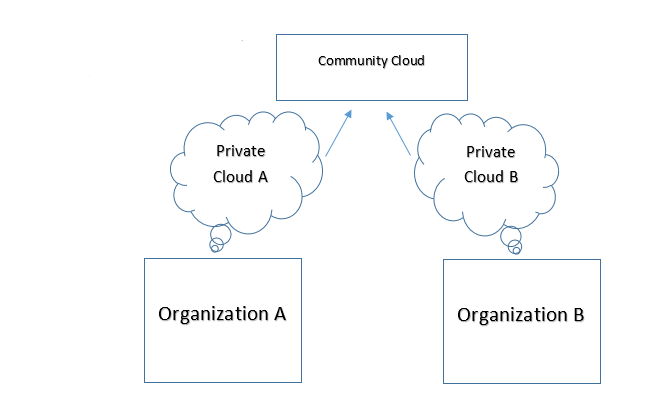What is community cloud model?
Public, private and hybrid are the only models of computing that we have so frequently heard and read. However, there is another model based on a hybrid between public and private cloud models. This fourth model is called the community cloud.
In this wiki, we will answer some of the frequently asked questions in the domain of clouds, especially the community cloud. We have also included a diagram to facilitate easy understanding of this concept.
What do you mean by community cloud model?
Cloud computing, at present, deploys three fundamental models –
Public cloud is open for individuals to subscribe and use. Each user is allotted his own virtual dashboard and can access only his contents. Even though the system is public, the contents are private and no one other than the rightful owner can view files on the server.
Private clouds are kept somewhat away from the public. Access to private clouds is confined to individuals or employees of a certain organization. Put simply, no one other than the organization’s own members can have access to the cloud servers.
Hybrid clouds are made by combining the public and private cloud models into one. Businesses deploying hybrid models can use the public and private components interchangeable, scaling one at the expense of the other. The hybrid models are more useful in the sense that they unlock they allow deliveries through either end of the cloud.
Community clouds are built the same way as hybrid clouds. It is an amalgamation of two or more private and/or public cloud models.
Community cloud definition and examples
Say an android app development firm A wants to collaborate with an iOS app development company B. The two CEOs decide to lease a collaborative cloud hosting platform.
Both A and B will have their private clouds conglomerated to ease sharing of program codes with one another. This is the most apt example of community cloud.
Notice the two communities are still working on their own platforms and have only combined their private cloud terminal for the time being.
Definition
A community cloud in Cloud computing can be well defined as a mutual effort in which virtual infrastructure or cloud infrastructure is shared between several organizations that belong to a specific community. These organizations may also work with similar concerns like security, compliance and jurisdiction. The purpose of a community cloud is to have participating firms realize the benefits of public cloud such as multi-tenancy and pay as you go billing structure.
Benefits of community cloud
Since there are two (or more) communities involved, you might be wondering who benefits from using a community cloud. We have compiled an exhaustive list of possible scenarios and the advantages conveyed in each case –
- Business merger – two organizations are likely to deploy community cloud when they undergo a merger or one occupies the other. Having a single platform is much simpler and makes things easier to manage.
- Business bifurcation – it may happen sometimes that a company decides to bifurcate its business into two or more constituents. While all the bifurcated pillar would run under the same company, they can have their operations branched off from each other. So, it makes sense to also split their existing cloud equally, thus combining each cloud model into one community cloud.
- Business collaboration – a business might neither split nor merge yet still be able to collaborate with another organization for some time until both have mutually benefitted. This is most often seen where a business lacks critical expertise and needs to collaborate with other businesses. This collaboration is also brought into effect through community cloud and both parties benefit equally with it.
Community cloud diagram

Section community cloud definition and examples will help you to comprehend the diagram. Notice how organization A and B are engaging their private computing platforms into conglomeration to create the community cloud.
Public cloud vs community cloud
|
Public cloud
|
Community cloud
|
|
Public cloud is an open computing platform.
|
Community cloud is reserved for use by specific communities.
|
|
Public cloud can have users irrespective of the organization they work.
|
Community cloud will have users from the given community only
|
|
Based on public computing model
|
It is predominantly a private cloud model
|
|
Most convenient and affordable for individual use
|
Convenient for businesses undergoing a merger or bifurcation.
|
Private vs Community Cloud
|
Private Cloud
|
Community Cloud
|
|
Hosted and owned by the enterprise
|
Hosted and owned by the community (third-party)
|
|
Suitable for large businesses
|
Suitable for businesses undergoing merger/acquisition/collaboration
|
|
Private clouds are quite costly.
|
A Community cloud is far more cost effective
|
|
Private clouds are the most secure form of cloud computing
|
Community clouds are also quite secure, but not as secure as a private set up.
|
Community Cloud vs Hybrid Cloud
|
Hybrid Cloud
|
Community Cloud
|
|
Hosted and owned by the enterprise
|
Hosted and owned by the community (third-party)
|
|
Suitable for small-and-medium-sized businesses
|
Suitable for businesses undergoing merger/acquisition/collaboration
|
|
Hybrid clouds are highly scalable
|
The scalability of a community cloud is somewhat limited
|
 Talk to Experts
Talk to Experts
 Live Chat
Live Chat









